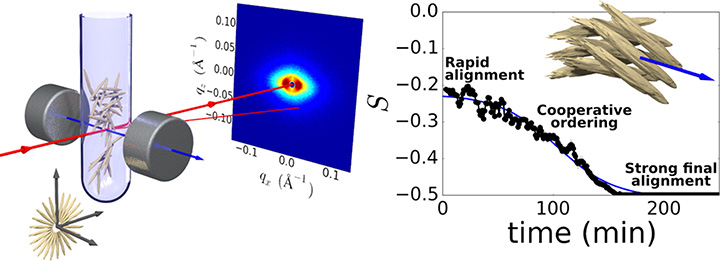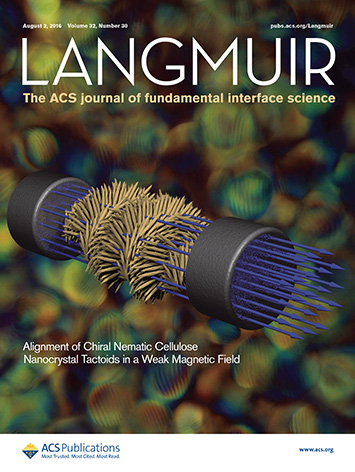Research Highlight: Easy Alignment of Elongated Renewable Nanomaterials
innovation at CFN
November 30, 2016
What is the scientific achievement?
Cellulose nanocrystals are nanomaterials that are derived from natural sources, including waste wood pulp originating from the paper production and forestry industries. These renewable nanomaterials hold great promise for the low-cost deployment of advanced technologies, such as chiral magneto-optical materials and biosensors. This work used the advanced characterization method of small-angle X-ray scattering to understand the alignment and ordering of rod-shaped cellulose nanocrystals placed in the presence of a magnetic field. Monitoring the in situ reorganization of these nanomaterials revealed an intriguing cooperative ordering phenomenon. The application of a magnetic field enabled control of the ordering and alignment of the nanomaterials, even in a weak field.
Why does this achievement matter?
Improved recognition and control over the ordering and alignment of these naturally derived nanomaterials broadens the range of applications that can be targeted. For example, tissue engineering scaffolds containing oriented cellulose nanocrystals may have the potential to promote directional cell growth and orientation-induced differentiation. However, nearly perfect orientation of the nanocrystals is required. This work demonstrated that cooperative ordering occurs in these systems, amplifying the alignment force of even very weak magnetic fields.

X-ray scattering measurements were used to characterize the alignment of cellulose nanocrystals within a magnetic field. A custom-built sample holder was used to perform the in situ magnetic field experiments. The kinetics of nanoparticle ordering demonstrate rapid cooperative interactions, even in the presence of a weak magnetic field.
What are the details?
CFN Capabilities: The lab-scale x-ray scattering instrument in CFN’s Materials Synthesis and Characterization Facility was used to study ordering behavior. Additionally, a custom sample holder, incorporating permanent magnets, was fabricated to enable the in situ study of nanomaterials within a magnetic field.

The inherent chiral assembly of nanoscale cellulose, combined with magnetic alignment, generates ordered domains ("tactoids") that exhibit chiral optical properties.
This work investigated how cellulose nanocrystals order in relatively weak magnetic fields, using small permanent magnets. With the CFN’s x-ray scattering instrument, this project studied the ordering of nanocrystals during magnetic alignment—that is, while the nanocrystals are reorganizing due to the magnetic field. The nanocrystals were found to order in a highly cooperative manner. Thus, at a sufficient nanocrystal concentration and magnetic field strength, the magnetic response of each individual nanocrystals is amplified, giving rise to a combined order and alignment that exceeds that expected for a single nanocrystal subjected to such a weak magnetic field. The kinetic results demonstrate a fast, cooperative alignment process, leading to nearly perfectly aligned samples. The magnetic anti-alignment of the crystals combines with the intrinsic chirality of cellulose to form chiral nematic domains ("tactoids”), which exhibit chiral optical properties.
Publication Reference
“Cooperative Ordering and Kinetics of Cellulose Nanocrystal Alignment in a Magnetic Field”
Kevin J. De France†, Kevin G. Yager‡, Todd Hoare†, and Emily D. Cranston†
† Department of Chemical Engineering, McMaster University, 1280 Main Street West, Hamilton, ON L8S 4L8, Canada
‡ Center for Functional Nanomaterials, Brookhaven National Laboratory, Upton, New York, 11973, United States
Langmuir 32, 7564–7571 (2016)
Acknowledgement of Support
We thank Yugang Zhang and Dmytro Nykypanchuk for assistance with the in situ magnetic cell and Professor Jose Moran-Mirabal for assistance with polarized optical microscopy experiments. This research used resources of the Center for Functional Nanomaterials, which is a U.S. DOE Office of Science Facility, at Brookhaven National Laboratory under contract no. DE-SC0012704.
2016-6743 | INT/EXT | Newsroom









